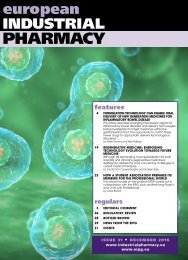PHARMACY
eip26-sep15
eip26-sep15
- No tags were found...
You also want an ePaper? Increase the reach of your titles
YUMPU automatically turns print PDFs into web optimized ePapers that Google loves.
IN SILICO CLINICAL TRIALS: DREAM OR CERTAINTY?<br />
continued<br />
The huge cost of developing new<br />
medical products has many<br />
consequences. Countries with<br />
universal healthcare struggle to<br />
afford the best new products, and in<br />
countries with private healthcare<br />
only the wealthy can afford the best<br />
treatments. Many conditions are<br />
ignored by the biomedical industry<br />
because they cannot return the<br />
significant investment needed for<br />
clinical trials – because the groups<br />
of people affected by the conditions<br />
are too small (e.g. Sanfilippo<br />
Syndrome) or too poor (e.g. Chagas<br />
disease).<br />
The Avicenna Consortium<br />
believes computer simulation is one<br />
solution that will contribute to<br />
revolutionising the clinical trials<br />
process. In all other industrial<br />
sectors, computer simulation plays<br />
an essential role in the design and<br />
assessment of new products. Given<br />
recent advances in medical imaging<br />
and other analytical technologies,<br />
the Avicenna Consortium asked if<br />
we have collected enough<br />
knowledge to start using computer<br />
simulation in the development of<br />
medical products. Could we use the<br />
computer simulation of individual<br />
patients’ bodies in the development<br />
or regulatory evaluation of a<br />
medicinal product, medical device<br />
or medical intervention? If we could,<br />
what would be the barriers to its<br />
widespread adoption?<br />
In its conclusions, the Avicenna<br />
Roadmap states that, in the opinion<br />
of the Consortium and the<br />
contributors to the Avicenna<br />
Research and Technological<br />
Roadmap, the use of individualised<br />
computer simulation in the<br />
development or regulatory<br />
evaluation of a medicinal product,<br />
medical device or medical<br />
intervention (generally referred to<br />
as “in silico clinical trials”) is one of<br />
the most important strategic<br />
priorities in biomedical and<br />
technological research, if we want<br />
to make the development and<br />
assessment of new biomedical<br />
products simpler, cheaper, faster<br />
and safer, whilst at the same time<br />
minimising those activities such as<br />
animal or human experimentation<br />
that pose ethical concerns. It<br />
recommends that all public and<br />
private research funding agencies<br />
across the world do the following.<br />
a) Acknowledge the significant<br />
socioeconomic relevance that<br />
research and technological<br />
development, assessment and<br />
adoption of in silico clinical trials<br />
technologies pose. The<br />
mounting needs of universal<br />
healthcare provision in<br />
developed countries exceed our<br />
ability to innovate quickly and<br />
efficiently, and in silico<br />
approaches are the best<br />
possible route to address those<br />
needs.<br />
b)Progressively increase the<br />
expenditure in this area in the<br />
next 5 years, so that by 2020 at<br />
least 1% of the total public and<br />
private expenditure in<br />
biomedical research and<br />
development worldwide<br />
(estimated as US $268 billion in<br />
2012) is dedicated to the<br />
development and adoption of<br />
in silico clinical trials<br />
technologies used to translate<br />
biomedical research discoveries<br />
into new products and services<br />
more quickly, safely and<br />
efficiently. This should be<br />
initiated with a dedicated<br />
programme in the 2016/17<br />
European Commission Work<br />
Programme of the European<br />
Union Horizon 2020<br />
programme, with a budget of at<br />
least €50 million per year.<br />
16 european INDUSTRIAL <strong>PHARMACY</strong> September 2015 • Issue 26





